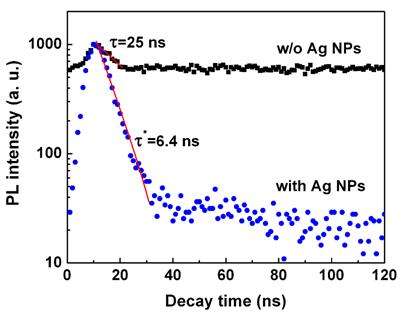| Enhancement of light-emission efficiency of ZnO light-emitting-diodes by Ag localized surface plasmons |
| From: PublishDate:2012-06-25 Hits: |
ZnO has substantial advantages including large exciton binding energy (60 meV) and direct wide band gap (3.37 eV) and has been regarded as one of the most promising candidates for ultraviolet (UV) light-emitting diodes (LEDs). However, there are many practical challenges that must be resolved before it leaps from lab to market-place. The most crucial one is to improve the light-emission efficiency with which the LEDs are more effective at converting electricity into light. A team from Key Lab of Semiconductor Materials Science in Chinese Academy of Sciences, has demonstrated that exploitation of localized surface plasmons (LSPs) is a feasible way to enhance the efficiency of ZnO LEDs. Their research has been published on November 3rd, 2011 in Applied Physics Letters. LSPs are collective excitation modes in metal nanoparticles (NPs), comprising an electromagnetic field coupled to oscillations of the conduction electrons. When the emission energy of semiconductor and the SP energy are similar, the luminescence efficiency of light-emitting materials and devices can be enhanced significantly by the resonance coupling between them. Although LSPs in principle can improve the light emission of LEDs, there has been no report concerning the LSP-enhanced electroluminescence (EL) in ZnO-based LEDs structure. For effective exciton-LSPs coupling, the NPs must locate in close proximity to the emitter. The strategy the team adopted is to incorporate Ag NPs in the vicinity of the active layer, but not the commonly used one, i.e., on the top of the device. The ultraviolet/violet near band edge emission of the device is significantly enhanced while the green defect-related emission is suppressed as compared to the LEDs without Ag NPs. A maximal 2.5-fold enhancement of electroluminescence was observed.
TR-PL spectra of the ZnO LEDs with and without Ag NPs measured at RT. The decay time is determined to be ~25 nm for the LED without Ag NPs, while it is reduced to ~6.4 ns after introducing Ag NPs. The data were collected at beam line 4B8 of BSRF with the exciting wavelength of 200 nm. Synchrotron sources helped the team to uncover the microscopic origin of the enhancement in light-emission efficiency. Time-resolved photoluminescence (TR-PL) measured at beam line 4B8 of Beijing Synchrotron Radiation Facility (BSRF) reveals that the decay time (i.e., the effective exciton lifetime) is greatly reduced from 25 ns to 6.4 ns after introducing Ag nanoparticles. This is because the exciton energies can transfer to the Ag LSPs for emission, creating an alternative recombination channel. The internal quantum efficiency (IQE) of the ZnO with exciton-LSP coupling can be described as η=(krad+ksp)/(krad+knon+ksp), where krad and knon are the radiative and nonradiative recombination rates of ZnO, respectively, and ksp is the exciton-LSP coupling rate. Due to ksp is very fast compared to krad and knon, the PL decay rate are largely enhanced. This new recombination path increases the spontaneous radiative recombination rate, and thereby the IQE of ZnO is significantly improved. The resultant enhancement factor of radiative recombination rate determined from the corresponding decay time is around 3.9, which is in accordance with the maximum EL enhancement ratio of 4.2 observed at 410 nm with a current of 6 mA. The research provides a promising method to enhance the performance of ZnO-based LEDs. “However, the results at this stage are preliminary. We still have a long way to go to solve all the problems on commercializing ZnO-based LEDs, and synchrotron radiation is surely helpful for that. It is lucky that we start well.” Said XingWang Zhang, the team leader and the professor of Key Lab of Semiconductor Materials Science, Institute of Semiconductors, Chinese Academy of Sciences.
Article: S. G. Zhang, X. W. Zhang,* Z. G. Yin, J. X. Wang, J. J. Dong, H. L. Gao, F. T. Si, S. S. Sun, and Y. Tao,Localized surface plasmon-enhanced electroluminescence from ZnO-based heterojunction light-emitting diodes, Applied Physics Letters, 2011, 99, 181116. |
|
|
| Chinese
Science Highlights
Home /
Copyright © 2011 - 2012 Beijing Synchrotron Radiation Facility


